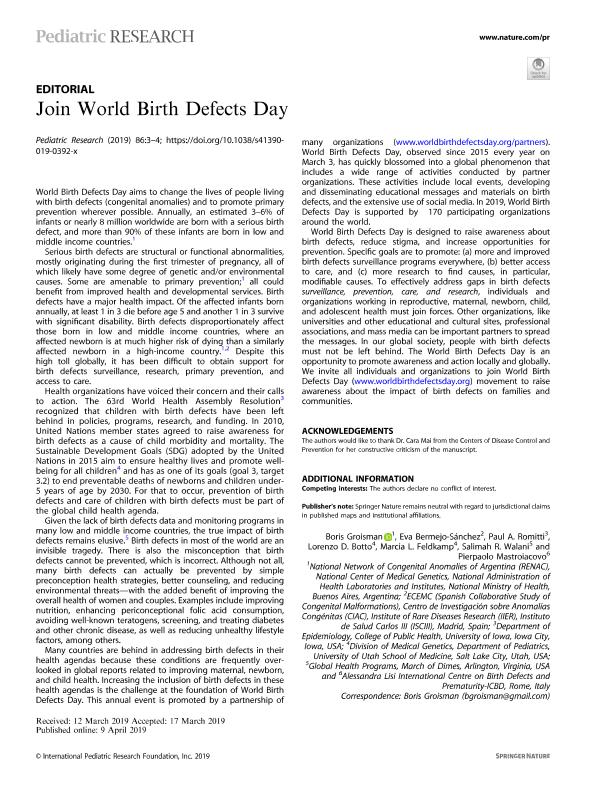Mostrar el registro sencillo del ítem
dc.contributor.author
Groisman, Boris

dc.contributor.author
Bermejo Sánchez, Eva
dc.contributor.author
Romitti, Paul A.
dc.contributor.author
Botto, Lorenzo

dc.contributor.author
Feldkamp, Marcia L.
dc.contributor.author
Walani, Salimah R.
dc.contributor.author
Mastroiacovo, Pierpaolo

dc.date.available
2021-05-28T19:22:55Z
dc.date.issued
2019-04-09
dc.identifier.citation
Groisman, Boris; Bermejo Sánchez, Eva; Romitti, Paul A.; Botto, Lorenzo; Feldkamp, Marcia L.; et al.; Join world birth defects day; International Pediatric Research Foundation; Pediatric Research; 86; 1; 9-4-2019; 3-4
dc.identifier.issn
0031-3998
dc.identifier.uri
http://hdl.handle.net/11336/132782
dc.description.abstract
World Birth Defects Day aims to change the lives of people living with birth defects (congenital anomalies) and to promote primary prevention wherever possible. Annually, an estimated 3–6% of infants or nearly 8 million worldwide are born with a serious birth defect, and more than 90% of these infants are born in low and middle income countries. Serious birth defects are structural or functional abnormalities, mostly originating during the first trimester of pregnancy, all of which likely have some degree of genetic and/or environmental causes. Some are amenable to primary prevention; all could benefit from improved health and developmental services. Birth defects have a major health impact. Of the affected infants born annually, at least 1 in 3 die before age 5 and another 1 in 3 survive with significant disability. Birth defects disproportionately affect those born in low and middle income countries, where an affected newborn is at much higher risk of dying than a similarly affected newborn in a high-income country. Despite this high toll globally, it has been difficult to obtain support for birth defects surveillance, research, primary prevention, and access to care.
dc.format
application/pdf
dc.language.iso
eng
dc.publisher
International Pediatric Research Foundation

dc.rights
info:eu-repo/semantics/openAccess
dc.rights.uri
https://creativecommons.org/licenses/by-nc-sa/2.5/ar/
dc.subject
Surveillance
dc.subject
World Birth Defects Day
dc.subject
Pregnancy
dc.subject
Rimary prevention
dc.subject.classification
Epidemiología

dc.subject.classification
Ciencias de la Salud

dc.subject.classification
CIENCIAS MÉDICAS Y DE LA SALUD

dc.title
Join world birth defects day
dc.type
info:eu-repo/semantics/article
dc.type
info:ar-repo/semantics/artículo
dc.type
info:eu-repo/semantics/publishedVersion
dc.date.updated
2021-05-27T12:38:49Z
dc.identifier.eissn
1530-0447
dc.journal.volume
86
dc.journal.number
1
dc.journal.pagination
3-4
dc.journal.pais
Estados Unidos

dc.journal.ciudad
The Woodlands, Texas
dc.description.fil
Fil: Groisman, Boris. Dirección Nacional de Instituto de Investigación. Administración Nacional de Laboratorios e Institutos de Salud "Dr. Carlos G. Malbrán". Centro Nacional de Genética Médica; Argentina. Consejo Nacional de Investigaciones Científicas y Técnicas; Argentina
dc.description.fil
Fil: Bermejo Sánchez, Eva. Instituto de Salud Carlos Iii (isciii);
dc.description.fil
Fil: Romitti, Paul A.. University of Iowa; Estados Unidos
dc.description.fil
Fil: Botto, Lorenzo. University of Utah; Estados Unidos
dc.description.fil
Fil: Feldkamp, Marcia L.. University of Utah; Estados Unidos
dc.description.fil
Fil: Walani, Salimah R.. March of Dimes. Global Health Programs; Estados Unidos
dc.description.fil
Fil: Mastroiacovo, Pierpaolo. Alessandra Lisi International Centre on Birth Defects and Prematurity-ICBD; Italia
dc.journal.title
Pediatric Research

dc.relation.alternativeid
info:eu-repo/semantics/altIdentifier/doi/http://dx.doi.org/10.1038/s41390-019-0392-x
dc.relation.alternativeid
info:eu-repo/semantics/altIdentifier/url/https://www.nature.com/articles/s41390-019-0392-x
Archivos asociados
